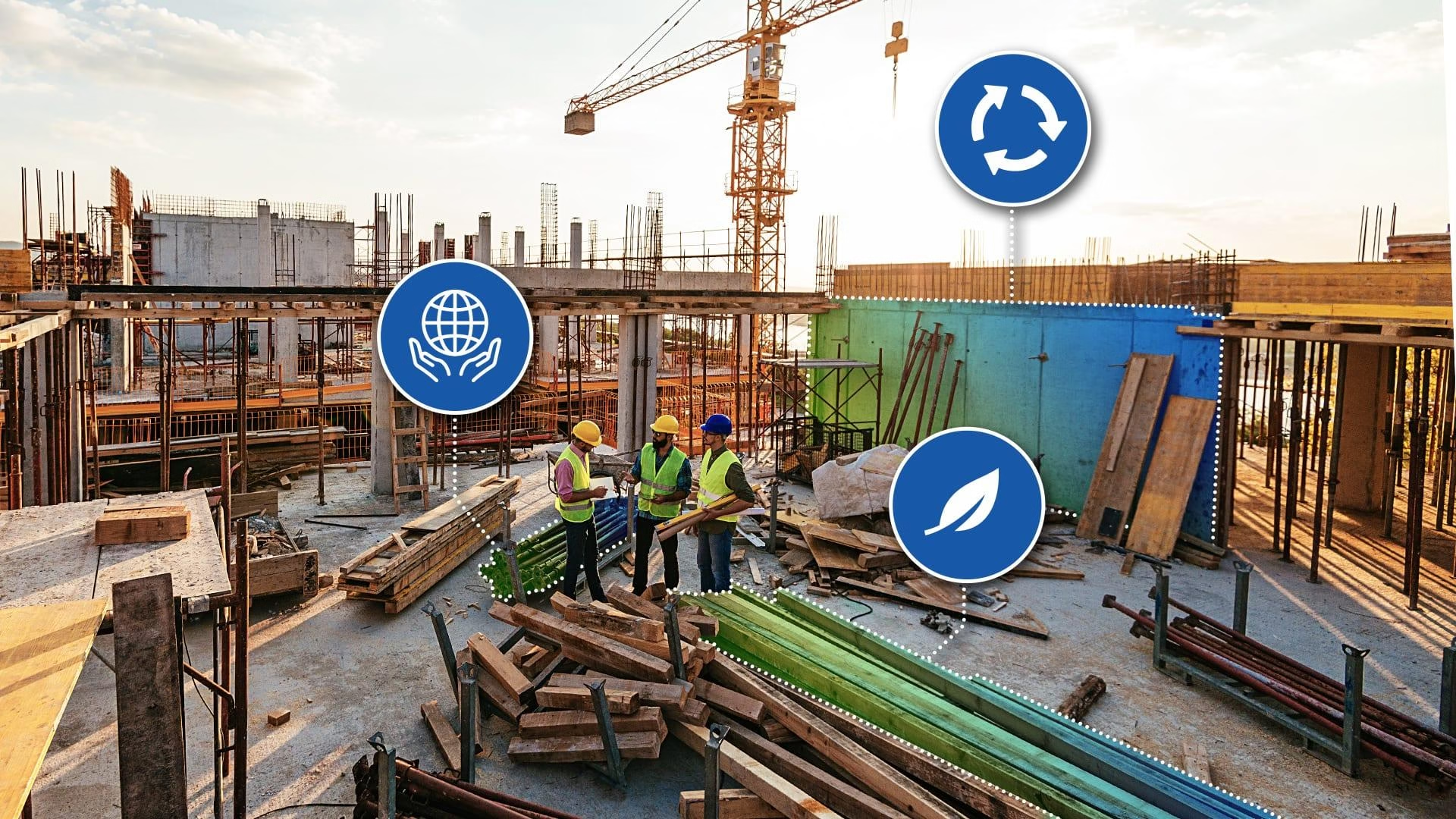
At a 2025 jobsite, the shift is easy to miss at first glance: quieter equipment, fewer deliveries, pallets labeled with digital passports, schedules driven by models rather than guesswork. Yet underneath, a structural change is underway. Clients, regulators, and insurers are asking not only what gets built, but how-measured in carbon, resource efficiency, resilience, and transparency. For builders, sustainability has moved from a marketing add-on to a performance requirement that affects bids, timelines, and margins.
This article examines practical strategies for delivering greener projects without losing focus on cost, safety, and program. It looks at choices that matter early-specifying lower-carbon materials, designing for disassembly, embedding lifecycle assessment-and at the operational levers on site: electrified equipment, waste minimization, water stewardship, biodiversity protection, and better logistics. It considers procurement models that reward verified outcomes, and digital tools-from BIM to digital twins-that make carbon and resource data visible and manageable across the supply chain.
The aim is not to offer a single blueprint, but a set of actionable options, trade-offs, and metrics that contractors, developers, and project teams can adapt to context. Greener building in 2025 is a discipline of decisions made from tender to turnover. Here is how to make them with clarity, consistency, and confidence.
In the race towards a decarbonized built environment, construction leaders are reimagining material choices from the ground up. The latest Environmental Product Declarations (EPDs) allow teams to compare products’ carbon footprints side-by-side, driving preference for low clinker cement, recycled steel, and FSC-certified timber. These shifts not only lower embodied carbon but also support circularity and local sourcing goals. By integrating EPD insights and proactively selecting alternatives, forward-thinking builders set new benchmarks for material transparency and accountability.
- Closed loop washout systems recycle concrete wash water, cutting runoff and water waste.
- Rain capture infrastructure supplies non-potable water for dust suppression and landscaping.
- Mobile water treatment plans ensure on-site compliance and resilience, even on remote sites.
| Solution | Key Benefit | Eco Impact |
|---|---|---|
| Battery Fleets | Zero-emission power tools & equipment | Slashes onsite diesel use |
| Renewable Microgrid | Clean energy for temporary needs | Reduces grid stress |
| Smart Charging | Efficient, scheduled recharging | Maximizes renewable use |
Verifying sustainable progress is now as high-tech as construction itself. ISO-aligned carbon accounting platforms offer traceable project emissions data; sensor-driven waste tracking exposes real-time inefficiencies. Combined with auditable ESG reporting, these innovations transform compliance from paperwork into powerful project insights, ensuring every claim is backed by tangible proof for regulators, clients, and communities.
Q&A
Q: What does it mean to be a “greener builder” in 2025?
A: It means managing whole‑life impacts-carbon, water, waste, biodiversity, and health-across design, procurement, construction, and operations. You’re not just meeting codes; you’re setting explicit targets, tracking outcomes with data, and delivering projects that are efficient, low‑carbon, resilient, and circular by design.
Q: Where should a project team start?
A: Start with targets and baselines. Define: whole‑life carbon (kgCO2e/m2 using EN 15978), energy use intensity (kWh/m2 or kBtu/ft2), water, waste diversion, biodiversity net gain, and indoor health metrics. Lock these into the brief and contracts, run an early LCA at concept design, and assign a carbon budget alongside the cost plan.
Q: What are the quickest embodied‑carbon wins?
A: Reduce, then replace. Optimize structure (right‑sizing members, efficient grids), cut over‑specification, substitute high‑cement concrete with low‑carbon mixes (SCMs, LC3, carbon‑mineralized), choose EAF steel with high recycled content, use biobased insulation where feasible, and prioritize reuse of components and finishes.
Q: How should we approach concrete specifically?
A: Use performance specs not prescriptive cement limits; set EPD‑based thresholds; swap cement with SCMs/calcined clays where curing and durability allow; consider carbon mineralization technologies; design for lower strength where appropriate; use efficient mix designs and curing, and confirm with on‑site maturity testing rather than blanket safety margins.
Q: What about steel, aluminum, and timber?
A: For steel and aluminum, specify products with verified EPDs, high recycled content, and low‑carbon energy in production; favor EAF steel and scrutinize imported materials under EU CBAM reporting. For timber, use responsibly sourced mass timber where structurally appropriate, model fire and moisture performance carefully, and design for disassembly with bolted connections.
Q: How do we cut operational carbon without compromising comfort?
A: Electrify with high‑efficiency heat pumps, right‑size equipment, improve envelopes (airtightness, high‑performance glazing), deploy heat recovery and DOAS, integrate smart controls and sub‑metering, add on‑site PV and, where practical, storage. Choose low‑GWP refrigerants and implement leak detection.
Q: Are foams out for insulation?
A: Not entirely, but use them deliberately. Favor lower‑embodied‑carbon options like cellulose, wood fiber, or mineral wool. Where foams are necessary (e.g., under slabs), choose HFO‑blown products and avoid high‑GWP blowing agents like those still present in some XPS.
Q: What does a low‑carbon jobsite look like?
A: Grid‑tied or renewable temporary power where possible, battery energy storage for peaks, electric or hybrid equipment, verified renewable diesel (HVO) as a transitional fuel with robust chain‑of‑custody checks, anti‑idling policies, telematics for utilization, consolidated deliveries, and rigorous waste segregation and tracking.
Q: Which digital tools matter now?
A: BIM integrated with LCA platforms (e.g., One Click LCA, EC3, Tally, eTool), EPD databases aligned with EN 15804+A2/ISO 21930, 4D/5D BIM for sequencing and logistics, digital twins for commissioning and handover, and material passports to support future reuse. Use AI‑assisted optioneering for early‑stage massing and structural trade‑offs.
Q: How does circularity show up on real projects?
A: Pre‑demolition audits; salvage and reuse of structure, facades, and MEP; DfMA and design for disassembly; standardized, bolted connections; modular MEP skids; take‑back programs (e.g., flooring, ceiling tiles); and product‑as‑a‑service models (e.g., lighting) that align incentives for longevity.
Q: Are retrofits actually greener than new builds?
A: In most cases yes. Retaining structure preserves large amounts of embodied carbon. Deep retrofits plus electrification often outperform new construction on whole‑life carbon, especially when grid carbon intensity is falling.
Q: What codes and policies are shifting practice in 2025?
A: Jurisdictions adopting the 2024 IECC are raising efficiency and electrification readiness; California’s CALGreen now requires embodied‑carbon reductions for certain large buildings; the UK Future Homes/Buildings Standards push low‑carbon new builds; UK biodiversity net gain is mandated; EU CBAM transitional reporting continues to affect steel/cement supply; many public clients include zero‑emission construction site requirements and NEC4 Option X29 climate clauses.
Q: Which standards should we use for carbon accounting?
A: Use EN 15978 for building life‑cycle stages, RICS Whole Life Carbon for Buildings as a method framework, ISO 14040/44 for LCA, and EPDs per EN 15804+A2/ISO 21930. Align organizational reporting with the GHG Protocol. For infrastructure, PAS 2080 supports carbon management.
Q: What certifications are relevant?
A: Updated versions of LEED and BREEAM place stronger emphasis on carbon and performance outcomes. Other frameworks-WELL for health, Living Building Challenge for deep sustainability, CEEQUAL for infrastructure-can be layered where appropriate. Industry initiatives like SE 2050, MEP 2040, and the Contractor’s Commitment signal credible trajectories.
Q: How do we procure low‑carbon without inflating costs?
A: Use performance specifications, set EPD‑based maximums, and allow bid alternates. Prequalify suppliers with transparent data, lock in long‑lead low‑carbon materials early, leverage volume agreements, and evaluate bids on total cost of ownership and carbon, not just first cost. Integrate carbon targets into contracts and milestones.
Q: What about the supply chain risks behind “green” products?
A: Require third‑party verified EPDs, FSC or equivalent for timber, documented recycled content, and human‑rights due diligence. Avoid ambiguous claims; align with ISO 14021 guidance. Track evolving rules (e.g., EU green claims initiatives, FTC Green Guides updates) to reduce the risk of greenwashing.
Q: How can biodiversity and water be part of the construction plan?
A: Design nature‑based stormwater systems, green roofs, native plantings, habitat features, and shade trees to cut heat‑island impacts. Harvest rainwater, reuse greywater where allowed, and specify efficient fixtures. Plan for construction‑phase protection of soils, roots, and waterways.
Q: What does climate resilience look like in specifications?
A: Site‑specific risk assessments (heat, flood, wind, fire), passive survivability targets, flood‑resistant detailing, cool roofs and high‑albedo pavements, shading, redundancy for critical systems, and materials rated for projected future conditions-not just historical averages.
Q: Are there credible “new materials” to watch?
A: Yes, but verify. Low‑clinker cements (e.g., LC3), carbon‑mineralized concrete, geopolymer mixes in select applications, recycled/re‑made steel and aluminum powered by renewables, biobased products like hemp‑lime and straw panels for certain assemblies, and warm‑mix asphalt. Pilot carefully and insist on data for strength, durability, and fire performance.
Q: How do incentives and financing play in?
A: Look for green bonds and sustainability‑linked loans keyed to measurable KPIs, public procurement bonuses for low‑carbon materials, and tax incentives for efficiency, electrification, and on‑site renewables (varies by country; in the U.S., IRA‑related credits apply). Many measures are cost‑neutral when integrated early and evaluated on total lifecycle cost.
Q: What should happen at handover to lock in performance?
A: Verify with commissioning and measurement and verification plans, provide clear O&M manuals, enable continuous monitoring via sub‑metering and analytics, train operators, and set up post‑occupancy evaluation. Use a soft‑landing period to align design intent with real operation.
Q: How do we bring the workforce along?
A: Upskill crews on new equipment and materials, embed carbon literacy in toolbox talks, use digital playbooks and QR‑coded EPDs on site, and engage trade partners early on sequencing for waste and rework reduction. Safety remains first; new methods must be matched with robust procedures.
Q: If I only have 90 days to make progress, what should I do?
A:
- Set a company policy for whole‑life carbon with project‑level targets.
- Choose an LCA tool and run baselines on two active projects.
- Issue a supplier survey for EPD availability and low‑carbon options.
- Pilot one low‑carbon concrete mix and one electric machine on site.
- Update bid templates to accept performance‑based low‑carbon alternates.
- Train PMs and supers on jobsite energy, waste tracking, and anti‑idling.
Q: What will distinguish leading builders by the end of 2025?
A: Transparent, verified data; reliable delivery of low‑carbon materials at scale; zero‑ or ultra‑low‑emission sites; circular design details that actually get reused; resilient, comfortable buildings with low running costs; and contracts that align every party to measurable climate outcomes.
To Wrap It Up
As 2025 unfolds, sustainability in construction looks less like a banner and more like a checklist-pragmatic, traceable, and shared. The path forward isn’t a single breakthrough but a sequence of small, well-measured choices: specifying lower-carbon mixes where they perform, electrifying equipment where it pencils out, designing for disassembly, and planning with data instead of assumptions. When owners, designers, contractors, and suppliers work from the same page-and the same numbers-greener becomes another word for better built.
Each project is a temporary assembly of materials borrowing time from the future. The craft now is to return that loan with interest: lighter footprints, longer service lives, clearer records for the next team. With the tools and standards available in 2025, the gap between intention and outcome is narrower than ever, and progress tends to be incremental, compounding, and visible.
In the end, the blueprint for a greener builder is already on the table. It begins with measuring, grows through collaboration, and matures through iteration-leaving a cleaner margin for those who build after.

